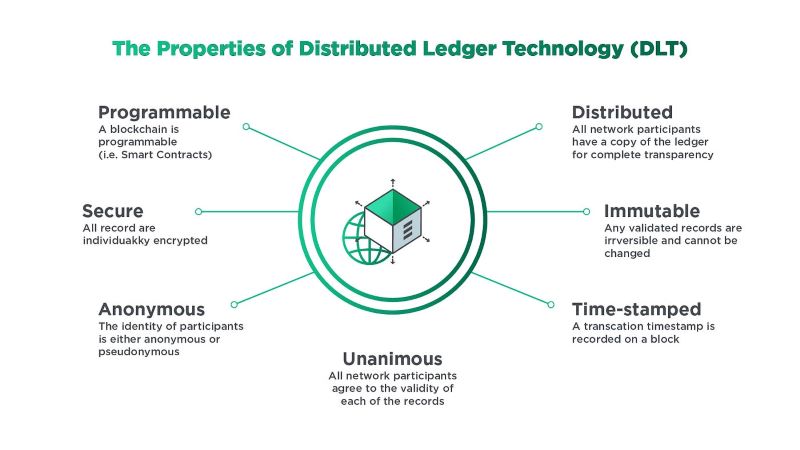Distributed Ledger Technology Unveiled: Revolutionizing Crypto Transactions
Have you ever asked, “What is distributed ledger technology in crypto?” Simply, DLT is a tech game-changer in how we handle digital money. It’s not just a tech buzzword; it’s the backbone of secure and open crypto deals. Join me in ripping off the mystery cover from DLT. Here, you’ll get why it’s a big deal and how it blows old-school crypto tech out of the water. We look at how it builds trust and what it means for your digital wallet’s future. Get ready to see how DLT in crypto makes your money safer and your transactions crystal clear!
Understanding the Core of Distributed Ledger Technology
Exploring the Essentials of DLT
Ever wonder how crypto keeps a spotless record? Say hello to DLT, your crypto’s secret keeper. It’s like a digital ledger but spread across many places at once. Every part of the network gets a look, ensuring no sneaky changes go unnoticed. This shared checking makes your crypto safe and sound.
Now, fasten your seatbelt; things get cooler. This tech lets everyone join the network. But here’s the kicker – you don’t have to trust anyone. With all eyes on the books, it’s tough for any funny business to slip by. Trust comes from the open checks by the whole network, not just a promise.
Ledgers can also talk with each other. That’s interoperability. Think of it like a group project. Everyone works together, each with their own piece, but it all fits in one big picture. This makes sure your crypto doesn’t get stuck in just one place.
Comparing DLT with Traditional Blockchain Systems
Now, let’s stack DLT up against regular blockchain systems. The big idea is, all blockchains are DLTs, but not all DLTs are blockchains. Got it? Good. Let’s dive into that.
Your standard blockchain is a train of blocks, each linked and full of transaction history. It’s tight, secure, and tough to mess with. Yet, it’s a team player, with all network players keeping an eye on it. This teamwork is what we see in DLT too.
The twist comes with other DLT types. Not every ledger needs to form these blockchains. Some prefer to mix it up, using different shapes and sizes of records. This could mean faster, smoother rides for your transactions.
Now, the heartbeat of DLT, the consensus mechanisms, keep everyone in sync. They’re the umpires, making sure all plays follow the rules. With solid umpires, the network hums along, a well-oiled machine. No block can turn rogue, no ledger can go wild. They all follow a beat, keeping crypto affairs in line.
In the end, DLT is more than a techie buzzword. It’s a smart, strong backbone for the bustling world of crypto. Each transaction is clear as day, thanks to this shared ledger that never forgets. Businesses dig it too, trading goods across the globe without a worry.
With DLT, you get a peek into the future. A future where transactions glide like ice-skaters. Where trust comes built-in, not bolted on. It’s the shield and sword against those wanting to pinch your digital coins.
This new world is ours to shape, with DLT as our trusty guide. The road ahead is clear, and it’s paved with shared ledgers, each telling tales of honest, open deals. Here, your crypto thrives, guarded by the collective power of a network that never sleeps.
The Impact of DLT on Cryptocurrency Security and Transparency
Enhancing Crypto Security with Advanced DLT Mechanisms
Imagine a world where all trade is open and safe. That’s the dream of crypto! To make this real, we use something called distributed ledger technology, or DLT for short. This tech spreads out data across many places at once. This way, it’s not easy for hackers to mess with it.
But how does DLT do this? It’s like a puzzle that all the pieces need to agree on to fit. All parts of the network, which we call nodes, must say “yes” to a change. If they don’t, it doesn’t happen. It’s teamwork! This is a process called consensus. It means no single person has all the power.
Security gets even stronger because of something called cryptography. Think secret codes that only certain people can crack. With this, your crypto stays locked up tight until it should move.
Now, there are different ways to set up these ledgers. You might have heard of public ledgers where anyone can see and join, like Bitcoin. Then there are private ones where invite-only members get in.
How Transparency is Achieved in Crypto Transactions through DLT
What about keeping things clear so everyone can see what’s up? That’s transparency! In crypto, DLT helps all the users on the network see every trade. No tricks or hidden moves. When someone sends crypto, DLT puts all the details out there. If I send you some coins, everyone knows, but they can’t change it. It’s like posting a notice in town square where it stays forever.
Trust is a big deal in the crypto world. DLT helps build that trust by letting people deal with each other directly. There’s no need for a middleman. Say goodbye to banks telling us what we can or can’t do with our money! This is the trustless system in crypto, and it’s a game-changer.
Smart contracts are another cool tool. These contracts are like deals that do stuff on their own when conditions are met. Think of a vending machine. You put money in, you get snacks out. Smart contracts do the same with digital things.
You might wonder, can these ledgers talk to each other? Yep, that’s interoperability! Imagine being able to send messages from any phone to any other phone. With DLT, different crypto systems can work together like that.
DLT is not just about money either. It’s used for keeping track of stuff like who made a product and where it went. It’s huge for things like supply chains.
In a world that’s more connected every day, crypto and DLT help us trade safely and openly. It’s like a magic spell against fraud and confusion, bringing power to the people. And in my journey as a DLT whiz, I keep reminding folks that these ledgers are not just tech talk – they’re our future!
The Mechanics Behind DLT: Consensus and Interoperability
Deciphering Consensus Mechanisms in Distributed Ledgers
Ever wonder how all the computers in a crypto network agree on something? That’s where consensus comes in, the heart of DLT. It’s like a game where all players must agree on the next move. This keeps everyone honest and secures the network.
Different ledgers use different rules for this game. Bitcoin uses a method called mining. It’s a tough number puzzle and the first to solve it, wins. They get to add a new page, or ‘block’, to the Bitcoin record book, and earn some coins as a prize.
But mining takes a lot of work and power. So, other ledgers try different games. Some use less power and check who has the most coins or the most age on their coins. This way, they strike a balance between keeping things secure and not burning too much power.
Achieving Interoperability Among Different DLT Platforms
Now let’s switch gears to interoperability. It’s a big word, but it’s not so complex. It means different ledger systems talking and working together.
Imagine speaking one language at home and another at school. Interoperability is like everyone learning a bit of both languages. When all ledgers understand each other, moving crypto around gets easier. You can send coins from one type of ledger to another with no fuss.
For example, if Alice uses ledger A and Bob uses ledger B, with interoperability, Alice can send coins to Bob even if they use different systems. They just need a common “language” or a middleman who speaks both.
Interledger is a project for this. It’s a bridge that connects various ledgers. Think of it as an interpreter who helps two folks who speak different languages to chat and do business.
In the world of DLT, these bridges make trading and working with different cryptos smooth. They make sure that, no matter the ledger, everyone can join the game.
Consensus keeps the game fair, and interoperability invites more players to the table. Together, they make DLT a powerful tool for the crypto world.
The Integration of DLT Across Financial and Technological Spheres
Illuminating the Benefits and Challenges of DLT in Financial Services
Distributed ledger technology, or DLT, is much more than a buzzword in the financial world. It’s changing how we handle money in a big way. Think of it as a digital system for recording who owns what. It’s like a shared notebook that everyone can see, but no one can mess with. This system does not live on one computer but spans across a network of many, making it tough to tamper with.
Using DLT, banks and other firms can cut down on costs and speed up transactions. It’s a win-win. Money can move across the globe faster than sending an email. Plus, every deal is transparent and secure, thanks to complex math called cryptography. But, it’s not all smooth sailing. Some find it hard to understand DLT or fear the change it brings. So, not everyone’s on board yet.
The Forward-Moving Trajectory of DLT in the Cryptocurrency Ecosystem
Now, when it comes to crypto, DLT is a game-changer. It’s the backbone of all cryptocurrencies. It lets you send and receive digital money without needing a bank in the middle. You can trust the system without trusting any one person. That’s because all users help run the network. We call this a trustless system, but it’s trustworthier than it sounds.
Crypto lives on DLT because it’s safe, open, and can handle a lot of info. It’s like a vast puzzle, and all the pieces fit just right. We also have smart contracts now. They’re like regular contracts but live on DLT. They work on their own, without anyone pulling the strings. This means less error and no cheating.
As more folks use crypto, DLT grows with them. It’s always getting better, faster, and can talk to more types of tech. We say it’s scalable and interoperable. Because of DLT, digital cash is now a real choice for buying things, not just for tech fans.
I help businesses ride this wave without falling off. With DLT, they can feel sure about tackling fraud, managing digital assets, and following the rules, even with money zooming across borders. It’s not just the future; it’s happening right now. Ipsum It’s an exciting time where tech meets trust, and I’m here to guide folks through it.
In this post, we uncovered the nuts and bolts of Distributed Ledger Technology (DLT), showing how it goes beyond typical blockchain systems to offer better security and openness in crypto dealings. With advanced consensus methods, DLT allows different platforms to work together smoothly, making sure your transactions are safe and easy to track.
We dug into how DLT secures your crypto assets and makes every transaction crystal clear. This tech is not just a game-changer in finance, but it’s also reshaping how tech spaces use money.
By embracing DLT, financial and tech industries are stepping into a future where money moves safely and quickly. Yes, there are hurdles, but the payoffs are huge for everyone involved. Stick with DLT, and you’re on track to a more secure, open financial world.
Q&A :
What is Distributed Ledger Technology (DLT) in Cryptocurrency?
Distributed Ledger Technology, commonly known as DLT, is a digital system for recording the transaction of assets where the transactions and their details are recorded in multiple places at the same time. Unlike traditional databases, DLT has no central data store or administration functionality. In cryptocurrency, DLT is the backbone of the blockchain, which is the technology behind Bitcoin and other cryptocurrencies, ensuring a high level of security and decentralization.
How Does Distributed Ledger Technology Work within the Crypto Space?
In the context of cryptocurrencies, DLT works by allowing every participant on the network (often referred to as a node) to have access to the entire database and its complete history. No single participant controls the data or the information. Every participant can verify the records of its transaction partners directly, without an intermediary. Transactions are recorded only once, eliminating the duplication of effort typical of a traditional business network with a centralized ledger.
Why is Distributed Ledger Technology Considered Secure in Cryptocurrency?
DLT is considered secure in cryptocurrency because it reduces the chances of fraud and error. Cryptographic algorithms and decentralized data storage are utilized, making it difficult for fraudulent activities to occur. Each transaction is encrypted and linked to the previous one, and once information is recorded, it is nearly impossible to alter. This creates an immutable and transparent system, which is ideal for recording the transfer of cryptocurrencies.
What Are the Advantages of Using DLT in Cryptocurrency?
Using DLT in cryptocurrency presents multiple advantages including increased security and immutability, lower costs by eliminating the need for middlemen, faster transactions outside of traditional banking hours, and improved accuracy through consensus mechanisms that validate transactions. DLT also provides transparency, as all network participants have access to the same ledger records, enhancing trust among users.
Can Distributed Ledger Technology be Separated from Cryptocurrency?
Distributed Ledger Technology is a foundational component of cryptocurrencies, providing the framework for these digital assets to operate. However, DLT is not restricted to cryptocurrencies and can be applied to other areas like supply chain management, voting systems, and healthcare record keeping. Its application beyond the financial sector demonstrates its versatility and the possibility of it existing independently from digital currencies.


